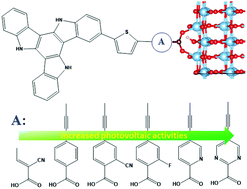Molecular engineering of anchoring groups for designing efficient triazatruxene-based organic dye-sensitized solar cells†
Abstract
Herein, we present a theoretical investigation of a series of metal-free organic dyes containing triazatruxene to explore the effect of designed anchoring groups on their photovoltaic properties and electron injection efficiencies for their potential applications in dye-sensitized solar cells (DSSCs). Density functional theory (DFT) and time-dependent DFT calculations are performed to provide a systematic analysis on the effect of different designed anchoring groups over the widely used anchor cyanoacrylic acid. A detailed assessment of the computational results indicates that the newly designed anchors are capable of producing decent quality light absorption spanning the entire visible range of the solar spectrum, enabling an improved light harvesting capacity and open circuit voltage compared to that of cyanoacrylic acid. More importantly, an ultrafast electron injection is observed from the dyes embedded onto the TiO2 surface. The interfacial electron transfer (IET) dynamics indicate that heteroatom substitution in the anchors offers more efficient electron injection. These findings are important in the context of providing guidelines for device modeling of highly efficient DSSCs.



 Please wait while we load your content...
Please wait while we load your content...